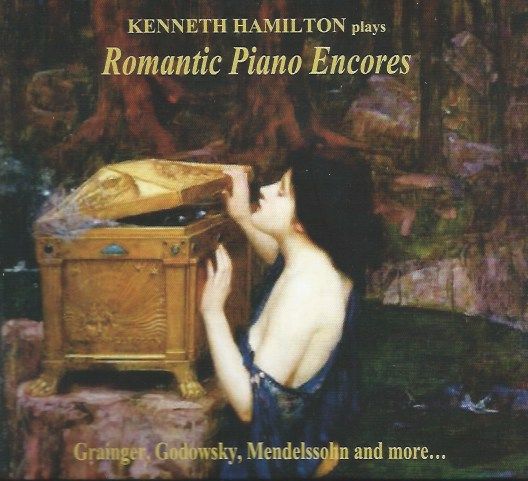Romantic Piano Encores from Kenneth Hamilton

The front cover image says it all: a young girl peeping inside a treasure chest to see what lies within. And what we have here is a treasure trove of sound - beautifully shaped performances of music both well-known and awaiting discovery, each performance shaped like an individual jewel.
Small wonder: Hamilton's book After the Golden Age, which examines just this sort of repertoire and cast of characters in detail, is a classic of its kind, a work of integrity, fine scholarship written with the zeal of an ardent performer. Hamilton is immersed in this music, and his self-authored booklet note itself traces the historu of encores, characteritsially including amusing oddities (Vladimir de Pachmann in particular). As Hamilton says, "some pianists were so prolific inproviding encores that they create d a'third half' of a concert programme'; in (fairly) reent times, Jorge Bolet was one who could notch up five or six encores (something I saw repeately in his Festival Hall concerts); Maurizio Pollini, too, has been generous with returning to the stage to laudatory applause (although he is rather guilty of encoring the same pieces:one knows what to expect!).
In a sense, while Chopin's Préludes are examples of "preluding" without a concrete entity to follow, here is a sequence of encores to an imagined preceding recital. The final piece Hamilton offers, Godowsky's Symphonic Metamorphosis on Johann Strauss' "Artist's Life" Waltz, is perhaps too large for an encore (it is a quarter of an horu long) but it has made it to Hamilton's public concerts in that manner (but with cuts). It is presented here complete perhaps as an extension of the core strategy of an encore, full of dazzle (heavy on the dazzle), beauty, and eminently satisfying. Let's hear it, and enjoy the sense of the waltz that Hamilton so brilliantly retains alongside the pyrotechnics:
In terms of programming, this is far more than any compliation that a record comapny might slap together to increase sales (and my word there are far too many of those). It is a concentrated study on a particular aspect of performance that yields discoevry after discovery: the encore. The voyage of discovery wends its way beautifully and unpredictably; when we get items that we might know (the Schumann/Liszt Widmung, for example), they seem to act as markers.
We begin with what Hamilton describes as "antiquarian" encores: early music reframed by Romantic masters. The Bach/Siloti Prelude in B-Minor is an oasis of peace (lovers of the Bach/Gounod Ave Maria will like this); Percy Grainger takes on Dowland in Now, O now, I needs must part before we have Bach in the hands of the amazing Alkan in the Siciliano, a moment of the utmost, lightly-spun beauty. In Hamilton's performance, the music seems to float in front of us:
That Schumann/Liszt Widmung is a thing of rare beauty, the line exquisitely spun, the "duets" between voices glorious. It feels like Liszt's version is less a transcription more of a celebration of Schumann's original:
Hamilton is clearly drawn to the music of Grainger - there are several examples here, perhaps the most striking of which is the Rosenkavalier Ramble, by no means as frivolous as its title might imply:
While Saint-Saëns' The Swan is as famous as can be (heard here in an arrangement by Lawrence Glover, one of Hamilton's teachers), Elgar's In Smyrna is much less so: movingly atmospheric. gentle and yet with little swirls that remind us of its ideal place as an encore, it is a little gem:
Let's close this post with a tender lullaby courtesy of Paderewski, a Nocturne in B flat, Op. 16/4, a lovely little piece with some wonderful little harmonic spicing:
